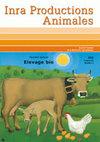法国山区反刍动物饲养的发展与展望
IF 0.6
4区 农林科学
Q3 Agricultural and Biological Sciences
引用次数: 16
摘要
由于山区利益相关者的活力和政府实施的支持政策,20世纪70年代法国山地农业的逐渐边缘化可以在全球范围内根除。像Beaufortain和Aubrac这样的一些山区的成功故事不应该掩盖山区内部和山区之间持续存在的差距或必要的公众支持,这些支持已经以各种形式的具体支持或主要受益于山地农业运行了40年。目前,16%的农场和14%的农业用地位于山区。山地农场面积与平原农场差异不大,但其经济实力较低,分别占全国奶牛、乳牛和绵羊存栏量的17%、23%和48%。对山地农场近期结构和生产变化的分析表明,山地农业用地、农场数量和农场资产减少的趋势较平原地区要低。目前,山区农民的收入虽然得到了一定的扶持,但与低地农民相比,山区农民的收入要低得多,而且差距最近还在扩大。未来,计划中的公共支持的增加将有助于限制收入差距。还必须加强山区利益攸关方的倡议,以降低生产成本和优化利用当地资源;他们的产品,环境,景观和文化的具体品质,更普遍的是他们的地区。本文章由计算机程序翻译,如有差异,请以英文原文为准。
Evolutions et perspectives de l'élevage des ruminants dans les montagnes françaises
The gradual marginalization of French mountain agriculture recorded into the 1970s could be globally eradicated thanks to the dynamism of the mountain stakeholders and support policies implemented by the government. The success stories of some mountain areas like Beaufortain and Aubrac should not overshadow the disparities that persist within and between mountain areas or the necessary public support, that have been running for 40 years in various forms of specific support or benefiting mainly mountain farming. Currently, 16% of farms and 14% of agricultural land are located in mountainous areas. The area of mountain farms differ little from those of the plain but their economic power is lower, in line with the proportion of forage that feed respectively 17, 23 and 48% of the national herd of dairy cows, suckler cows and sheep. The analysis of recent structural and productive changes in mountain farms reveals a rather positive trend: the mountain agricultural land and the number of farms and farm asset decrease was lower than in the plain. Currently, despite the supports, the income of farmers is much lower in the mountains than in the lowlands and the differences were increased recently. In the future, the planned increase of public support will be helpful to limit the differences of income. The initiatives of the mountain stakeholders will also have to be strengthened in order to decrease the production costs and optimize the use of their local resources; the specific qualities of their products, environment, landscape and culture and more generally their region.
求助全文
通过发布文献求助,成功后即可免费获取论文全文。
去求助
来源期刊

Inra Productions Animales
Multiple-
CiteScore
1.30
自引率
33.30%
发文量
0
审稿时长
>36 weeks
期刊介绍:
This journal publishes scientific update reports, results of experiments and their possible applications, analyses on topical issues and presentation of research, information on scientific events and new publications.
INRA Productions Animales deals with all species of zootechnical interest (herbivores, monogastrics and fish), covering feed and nutrition, physiology, pathology, genetics, production techniques, product quality and production economics.
 求助内容:
求助内容: 应助结果提醒方式:
应助结果提醒方式:


